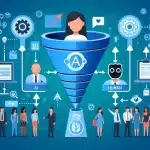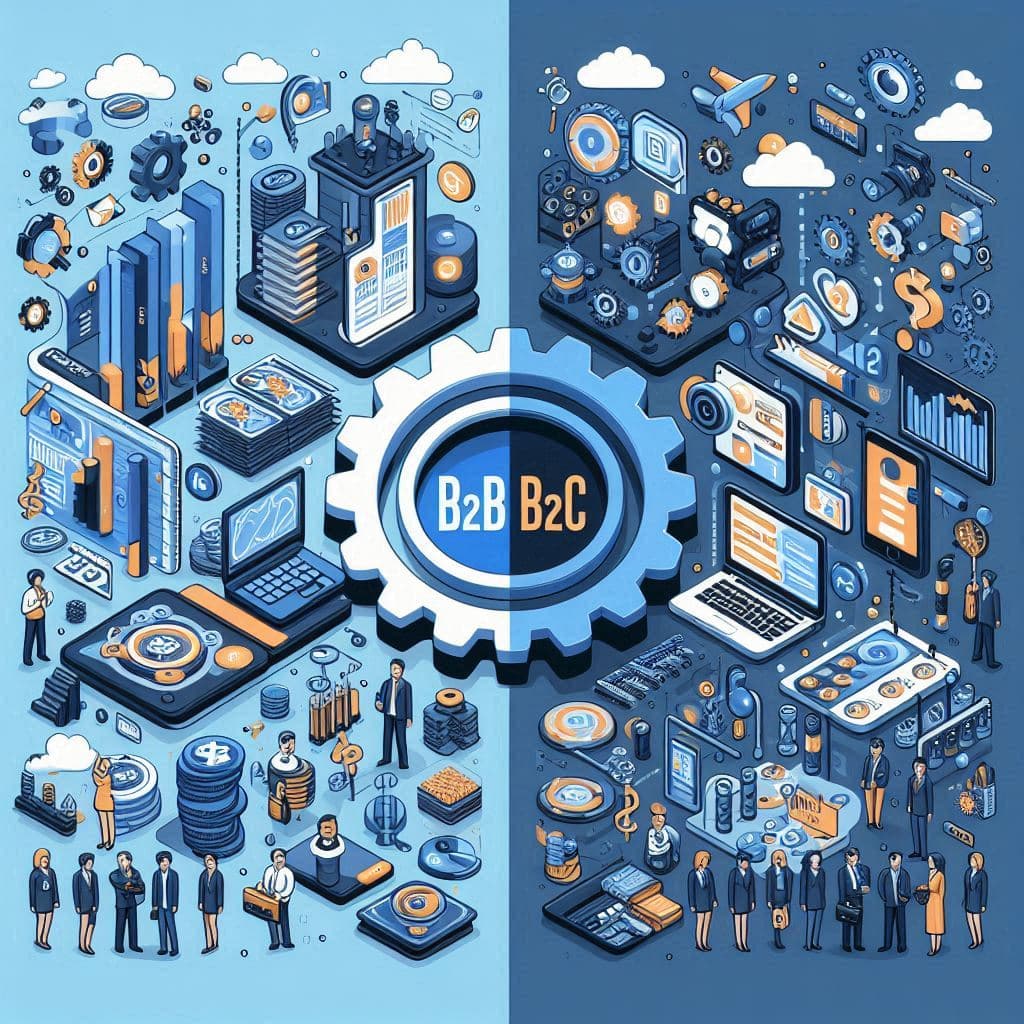
The difference between B2B and B2C marketing during the Christmas season
As the festive season approaches, businesses are preparing for one of the busiest times of the year. Whether you’re marketing to businesses (B2B) or directly to consumers (B2C), the goals may be similar—boost sales, increase visibility, and build relationships—but the strategies can differ significantly. Christmas also falls in the fourth quarter of the year, which for many is a crucial time for meeting annual targets. Whether it’s driving last-minute revenue or securing key partnerships, this period can determine how successfully businesses close out the year. In this article, we’ll explore the difference between B2B and B2C marketing during the Christmas season. While B2B marketing focuses on long-term decision-making, relationship building, and often higher-value transactions, B2C marketing tends to centre around driving quick sales and appealing to the emotional side of the festive spirit.
B2B vs. B2C marketing objectives during the Christmas season
While both B2B and B2C marketers aim to capitalise on the increased spending and urgency of the festive period, their objectives often differ significantly.
- B2B marketing objectives: In the B2B space, the Christmas season is typically focused on closing important deals and securing partnerships that have been in progress throughout the year. However, one key challenge is that Q4 can feel particularly short. Many decision-makers and key contacts are out of office, with attention shifting towards personal time as the Christmas and New Year holidays approach. This can create a sense of urgency to finalise deals earlier in the quarter. Businesses need to focus on delivering clear value and offering incentives that encourage stakeholders to act before the holiday slowdown begins.
- B2C marketing objectives: On the consumer side, the Christmas season is all about driving immediate sales. Emotions play a much larger role in B2C marketing, where campaigns often aim to tap into the festive mood, encouraging consumers to make purchases that either fulfil gift-giving needs or enhance their holiday experience. Discounts, time-limited offers, and convenience are key tools to capturing attention and converting interest into sales during this fast-paced period.
Key strategies for B2B and B2C marketing during Christmas
To achieve success during the Christmas season, both B2B and B2C marketers need to adjust their strategies to align with their unique objectives and target audiences. While the goals differ, adapting marketing efforts to fit the seasonal mindset is essential in driving results.
B2B marketing strategies:
- Personalised outreach: With the shorter decision-making window in Q4, personalised communication becomes even more important. Targeted emails or tailored proposals that speak directly to a prospect’s needs and pain points can help cut through the noise of the holiday season. Businesses that take the time to craft individualised messages are more likely to secure last-minute deals and push contracts over the line.
- End-of-year incentives: Offering incentives such as discounted service packages, flexible payment terms, or early access to new products can motivate businesses to act before the year ends. These offers can be positioned as limited-time opportunities that help decision-makers finalise their purchasing before the holiday break. Additionally, bundling services or providing bonus features on long-term contracts can also be effective.
- Capitalising on yearly budgets: Many businesses are closing their yearly budgets during this time, which presents a significant opportunity for those in the B2B sector. It’s important to understand what budget your clients or prospects might still have available and position your offers accordingly. Being prepared with tailored proposals that fit within those remaining budgets can help you secure last-minute contracts. Offering flexible pricing or discounted deals that align with their financial goals can further incentivise them to use their remaining budget before the year ends.
- Thought leadership and educational content: Many businesses use the end of the year to assess future needs and trends. Publishing thought leadership pieces such as blogs, reports, or whitepapers that address industry developments or provide insights for the upcoming year can position your business as a trusted advisor. Sharing such content demonstrates value and keeps your business front-of-mind during planning stages, setting up opportunities for future partnerships.
B2C marketing strategies:
- Festive-themed promotions: Consumers are primed for holiday shopping, and brands that lean into the festive atmosphere are likely to capture more attention. Seasonal promotions, Christmas collections, and time-limited offers tied to the holiday can drive urgency. Shoppers are looking for deals and inspiration, so offering curated gift guides or festive bundles can help simplify their purchase decisions while boosting sales.
- Social media engagement: With more consumers spending time on social media to find holiday inspiration, platforms like Instagram, Facebook, and TikTok become key tools for B2C brands. Running festive-themed campaigns, collaborating with influencers, and hosting holiday giveaways can help increase engagement and reach. User-generated content, such as asking customers to share their festive experiences with your products, can also amplify brand visibility organically.
- Emotional appeal: The Christmas season is a time of heightened emotion, and B2C brands can tap into this sentiment by sharing messages that reflect the joy, warmth, and generosity of the season. Campaigns that highlight stories of giving, community spirit, or holiday traditions often resonate deeply with consumers, helping brands build a stronger emotional connection. Whether through video content, heartfelt social posts, or charitable initiatives, these campaigns can foster goodwill and drive purchases.
- Considering affordability and payment options: Christmas is a time when many consumers are managing high levels of spending, from gifts to holiday events. To help ease the financial burden, it’s important for B2C businesses to offer flexible payment options. Partnering with payment providers that offer instalment plans, such as ‘buy now, pay later’ services, can make higher-ticket items more accessible. Offering instalment options allows consumers to spread the cost over time, which can encourage more purchases without overwhelming their budgets.
Timing and campaign planning for B2B and B2C marketing during Christmas
When it comes to Christmas marketing, timing is crucial. Understanding the differing buying cycles and decision-making processes in B2B and B2C marketing can help ensure your campaigns reach the right audience at the right time, maximising the potential for engagement and conversions.
B2B campaign timing:
B2B marketing typically requires a longer lead time, and the Christmas season shortens the window even further. Decision-makers tend to plan their budgets and purchases in advance, so campaigns targeting B2B clients should ideally launch early in Q4. October and early November are ideal times to build awareness, as businesses begin looking to finalise deals before the holiday period slows things down.
By mid-December, many B2B contacts will start to take time off for the holidays, so it’s important to account for this in your campaign schedule. Ensure that any relationship-building, negotiations, or proposal discussions happen well before the office closures that typically occur towards the end of the month. Follow-up communications and final calls to action should be scheduled with the aim of wrapping up deals by mid-December, allowing enough time for decision-makers to act before their attention shifts to personal matters.
B2C campaign timing:
In contrast to B2B, B2C marketing is often more immediate, with consumer buying behaviour peaking in the weeks leading up to Christmas. For B2C brands, the Christmas shopping season generally kicks off in November, with key dates like Black Friday and Cyber Monday serving as major opportunities to attract early shoppers. During this period, consumers are on the lookout for deals and may begin buying gifts and holiday essentials.
As December approaches, there is a shift towards more urgent, last-minute purchases. By mid-December, many consumers are focused on finding the perfect gift or securing holiday essentials, often with an eye on fast delivery and convenience. This makes it crucial for B2C brands to ramp up marketing efforts during the final two weeks before Christmas. Offering promotions, highlighting fast shipping options, and providing clear messaging around product availability can help capture last-minute buyers. Ensuring your marketing is staggered to cover both early and late shoppers is key to maximising sales.
Messaging and content strategies for B2B and B2C marketing during Christmas
The holiday season offers a unique opportunity to connect with your audience, but the approach to messaging and content should differ depending on whether you’re targeting businesses or consumers. Let’s explore how to tailor your content to make a meaningful impact during this time.
B2B messaging and content
For B2B marketing, the focus should remain on professionalism while acknowledging the seasonal context. It’s a great time to position your offerings as solutions that help businesses start the new year strong or achieve last-minute goals before year-end.
- Focus on value: Highlight how your product or service offers long-term benefits or solves specific business challenges. Ensure your messaging reinforces ROI and future growth.
- Educational content: Industry reports, trend analyses, and forecasts for the upcoming year can position your brand as a thought leader. Consider sending out a year-in-review or insights for the upcoming year, encouraging clients to think strategically.
- Client appreciation: Holiday greetings, social events and personalised thank-you messages can strengthen relationships. Showing appreciation for your clients’ business throughout the year creates goodwill going into the new year.
B2C messaging and content
- In B2C marketing, Christmas is all about emotions and timely action. Your content should focus on tapping into the festive spirit and driving sales during the heightened buying season.
- Emotional appeal: Highlight feelings of joy, togetherness, and the spirit of giving. Use storytelling in your campaigns to evoke positive emotions that connect with your audience.
- Promotional content: Gift guides, festive sales, and personalised product recommendations help drive purchases. Focus on offering solutions for last-minute shoppers with clear calls to action and urgency-driven messaging around limited-time deals or fast shipping.
Examples of successful B2B and B2C Christmas campaigns
Examining how other companies have approached their Christmas marketing can offer valuable insights. Below are examples of both B2B and B2C campaigns that successfully capitalised on the festive season.
B2B examples
- Salesforce: “End-of-Year Offers”
- Salesforce launched a campaign aimed at encouraging businesses to sign up for their CRM platform by offering exclusive discounts and incentives for year-end purchases. They highlighted how their solutions could help companies plan for the new year, manage growth, and optimise operations. The time-sensitive nature of these offers, combined with messaging around preparing for Q1, created a sense of urgency for businesses to finalise purchases before their budgets expired.
- HubSpot: “Holiday Hub”
- HubSpot created a seasonal content hub focused on providing businesses with end-of-year marketing resources. This hub featured trend reports, downloadable holiday campaign templates, and webinars on maximising sales before the year closed. HubSpot’s campaign focused on educating its audience, positioning the company as a valuable resource while subtly promoting its marketing automation tools to help businesses execute these strategies.
B2C examples
- John Lewis: “The Bear and the Hare”
- John Lewis, known for its emotional Christmas adverts, ran “The Bear and the Hare” campaign, which told a heartwarming story through animation. The campaign resonated with the Christmas spirit of love and friendship, helping to solidify the brand’s connection with the festive season. Alongside the advert, they sold related merchandise, boosting sales while deepening customer engagement through storytelling.
- Coca-Cola: “Share a Coke” Holiday Edition
- Coca-Cola took its popular “Share a Coke” campaign and gave it a festive twist by personalising bottles with seasonal names like “Santa” and “Elf.” They ran promotions encouraging customers to share personalised Coke bottles as gifts, tapping into the tradition of giving. This drove both sales and brand visibility, while encouraging consumers to engage on social media by sharing their personalised bottle experiences.
How to use email for B2B and B2C marketing over Q4 and the Christmas season
Email marketing remains one of the most effective tools for engaging both B2B and B2C audiences, especially during the high-stakes Christmas season. However, the approach and messaging should be tailored depending on whether you’re targeting businesses or consumers.
B2B email marketing strategies
- Focus on value and ROI: B2B buyers are often motivated by logic and long-term benefits. Email campaigns should highlight how your products or services can help businesses meet their year-end goals or prepare for a strong start in the new year. For example, offering end-of-year discounts on software licenses or services can motivate action.
- Segment your audience: Use segmentation to target decision-makers with content that resonates. You might send out industry-specific case studies, trend reports, or product demos. Personalised emails that speak directly to the needs of different sectors will increase engagement.
- Nurture existing relationships: The end of the year is a great time to nurture ongoing relationships. Sending personalised appreciation emails or exclusive offers to current clients can help strengthen partnerships and pave the way for renewed contracts in the new year.
B2C email marketing strategies
- Create urgency with time-limited offers: In B2C, holiday email campaigns thrive on urgency. Promoting time-limited discounts, free shipping, or special Christmas collections can drive quick sales. Include clear calls-to-action (CTAs) to encourage immediate purchasing.
- Leverage festive storytelling: Christmas is an emotional time for consumers, and storytelling works well in email campaigns. Whether it’s a heartwarming holiday message or a behind-the-scenes look at how your products enhance the festive experience, connecting with emotions can boost conversion rates.
- Personalise product recommendations: Consumers are often overwhelmed with options during the holiday season. Use data from previous purchases or browsing behaviour to send personalised product recommendations, making gift shopping easier and more appealing.
Wrap up
As Q4 approaches and the festive season kicks into full swing, both B2B and B2C marketers need to adapt their strategies to meet the unique demands of the Christmas period. Whether you’re focusing on long-term partnerships in the B2B space or driving immediate sales with B2C audiences, the right approach to timing, messaging, email marketing, and promotions can make all the difference. By planning ahead and tailoring your campaigns to the needs of your audience, you can close out the year on a high note.
If you’re looking for more ideas or personalised strategies to enhance your Christmas marketing efforts, don’t hesitate to get in touch with us. Our team is here to help you craft campaigns that capture the spirit of the season while driving measurable results.




















